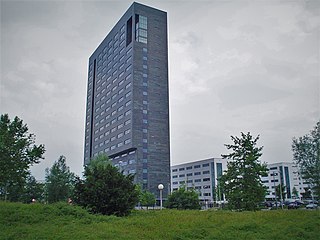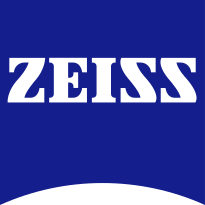Photolithography is a process used in the manufacturing of integrated circuits. It involves using light to transfer a pattern onto a substrate, typically a silicon wafer.

Carl Zeiss AG, branded as ZEISS, is a German manufacturer of optical systems and optoelectronics, founded in Jena, Germany in 1846 by optician Carl Zeiss. Together with Ernst Abbe and Otto Schott he laid the foundation for today's multinational company. The current company emerged from a reunification of Carl Zeiss companies in East and West Germany with a consolidation phase in the 1990s. ZEISS is active in four business segments with approximately equal revenue in almost 50 countries, has 30 production sites and around 25 development sites worldwide.

A photomask is an opaque plate with transparent areas that allow light to shine through in a defined pattern. Photomasks are commonly used in photolithography for the production of integrated circuits to produce a pattern on a thin wafer of material. In semiconductor manufacturing, a mask is sometimes called a reticle.

Immersion lithography is a technique used in semiconductor manufacturing to enhance the resolution and accuracy of the lithographic process. It involves using a liquid medium, typically water, between the lens and the wafer during exposure. By using a liquid with a higher refractive index than air, immersion lithography allows for smaller features to be created on the wafer.

The planar process is a manufacturing process used in the semiconductor industry to build individual components of a transistor, and in turn, connect those transistors together. It is the primary process by which silicon integrated circuit chips are built, and it is the most commonly used method of producing junctions during the manufacture of semiconductor devices. The process utilizes the surface passivation and thermal oxidation methods.

Schott AG is a German multinational glass company specializing in the manufacture of glass and glass-ceramics. Headquartered in Mainz, Rhineland-Palatinate, Germany, it is owned by the Carl Zeiss Foundation. The company's founder and namesake, Otto Schott, is credited with the invention of borosilicate glass.
Masklesslithography (MPL) is a photomask-less photolithography-like technology used to project or focal-spot write the image pattern onto a chemical resist-coated substrate by means of UV radiation or electron beam.
Nanolithography (NL) is a growing field of techniques within nanotechnology dealing with the engineering of nanometer-scale structures on various materials.

Extreme ultraviolet lithography is a technology used in the semiconductor industry for manufacturing integrated circuits (ICs). It is a type of photolithography that uses 13.5 nm extreme ultraviolet (EUV) light from a laser-pulsed tin (Sn) plasma to create intricate patterns on semiconductor substrates.

A stepper or wafer stepper is a device used in the manufacture of integrated circuits (ICs). It is an essential part of the process of photolithography, which creates millions of microscopic circuit elements on the surface of silicon wafers out of which chips are made. It is similar in operation to a slide projector or a photographic enlarger. The ICs that are made form the heart of computer processors, memory chips, and many other electronic devices.

ASML Holding N.V. is a Dutch multinational corporation founded in 1984. ASML specializes in the development and manufacturing of photolithography machines which are used to produce computer chips.

Phase-shift masks are photomasks that take advantage of the interference generated by phase differences to improve image resolution in photolithography. There exist alternating and attenuated phase shift masks. A phase-shift mask relies on the fact that light passing through a transparent media will undergo a phase change as a function of its optical thickness.
Resolution enhancement technologies are methods used to modify the photomasks in the lithographic processes used to make integrated circuits to compensate for limitations in the optical resolution of the projection systems. These processes allow the creation of features well beyond the limit that would normally apply due to the Rayleigh criterion. Modern technologies allow the creation of features on the order of 5 nanometers (nm), far below the normal resolution possible using deep ultraviolet (DUV) light.

Jenoptik AG is a Jena, Germany-based integrated photonics company. The company is listed on the Frankfurt Stock Exchange and is included in the TecDAX stock index.
The Fraunhofer Institute for Applied Optics and Precision Engineering (IOF), also referred to as the Fraunhofer IOF, is an institute of the Fraunhofer Society for the Advancement of Applied Research (FHG). The institute is based in Jena. Its activities are attributed to applied research and development in the branch of natural sciences in the field of optics and precision engineering. The institute was founded in 1992.

The Berthold Leibinger Innovationspreis is an award for given to those who have created applied laser technology and innovations on the application or generation of laser light. It is open to participants worldwide. It is biennially awarded by the German non-profit foundation Berthold Leibinger Stiftung. Three prizes are awarded worth 100,000 euros. The prize winners are selected from eight finalists that present their work person in a jury session. The jury is composed of international experts from different fields.
Computational lithography is the set of mathematical and algorithmic approaches designed to improve the resolution attainable through photolithography. Computational lithography came to the forefront of photolithography technologies in 2008 when the semiconductor industry faced challenges associated with the transition to a 22 nanometer CMOS microfabrication process and has become instrumental in further shrinking the design nodes and topology of semiconductor transistor manufacturing.
Suss Microtec is a supplier of equipment and process solutions for the semiconductor, nano and microsystems technology and related markets with headquarters in Garching near Munich.

Shanghai Micro Electronics Equipment (Group) Co., Ltd. (SMEE), is a semiconductor manufacturing equipment company based in Shanghai, China. The company is involved in the research, development, manufacture and sale of lithography scanners and inspection tools to the semiconductor manufacturing industry; it also provides support services to its customers.
Lasertec Corporation is a Japanese company based in Yokohama that specializes in the development, manufacture and distribution of inspection and measurement systems used primarily in the semiconductor industry. In its niche, the company is the global market leader. Lasertec pursues a fabless strategy and outsources production to subcontractors, allowing it to concentrate on research and development. Lasertec's shares are listed on the Tokyo Stock Exchange and are included in the Nikkei 225 index.











